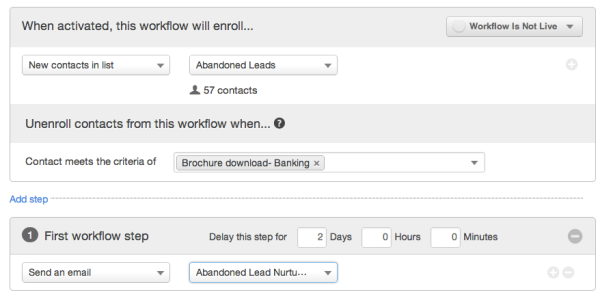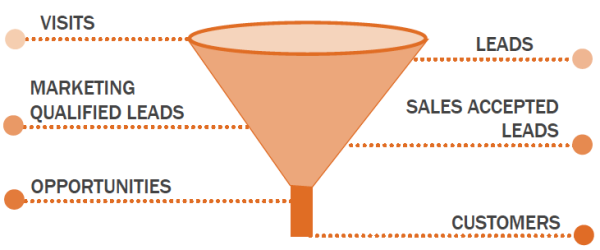
This blog post was inspired by and partially excerpted from our latest ebook, How to Execute Inbound: Three Lead Generation Success Stories. For deeper dives into the real-life applications of inbound marketing and how they can solve common problems faced by marketers -- Enterprise marketers, in particular -- download your free copy of the ebook.
Remember the last marketing revolution? A clever tagline, a catchy song, or a funny commercial could make or break your brand. Sure, consumers still appreciate these light-hearted things, but they’re simply not compelling enough to have prospects reaching for their wallets.
No one wants to be the dinosaur that gets left behind as industry standards change. But 2013 just might be the year of the mass dino exodus, as marketing executives everywhere are realizing the importance of delivering targeted, personalized content through inbound marketing.
The climate for marketing in the Enterprise arena, specifically, is changing rapidly; and the slew of traditional tactics like television advertising and trade shows aren’t jiving with changing buyer behaviors. Today’s buyers crave trust, relationships, and an exceptional customer experience from their providers. So in this post, we'll tackle three of the biggest problems Enterprise marketers face (but really, I think a lot of us feel these pains), and how marketing tools like list segmentation, marketing automation, and social media analytics can help solve them.
Common Problem #1: Abandoned Leads
Let’s face it, we’ve all had one before: a graveyard of abandoned leads. We remember a better time when our leads were engaged, and it seemed like a relationship between our company and this lead could blossom into something magical ... like an actual purchase. Unfortunately, something changed. They stopped opening our emails, and never converted on anything after the initial offer. Into the graveyard they go -- a bunch of abandoned leads. What a shame.
Even if inbound marketing didn’t bring them to your database in the first place, doesn’t mean it can’t help to revitalize their interest in your company. If your contacts database is integrated with your website and analytics, you’ll be able to segment these abandoned leads based on all the information you have about them, and reach out to them again with targeted communications that are appropriate based on the history of their interactions with your organization.
Enterprise business Ektron, for instance, identifies leads who have visited a landing page and not converted on the offer. They follow up with an email containing an offer that’s relevant to the lead based on all the information they have about the lead.

When all of your marketing tools are integrated, you can target those abandoned lead communications based on information from every marketing channel, including the types of pages they’ve looked at on your website. For example, if they’ve looked at your pricing page five times and have stopped reading blog posts about your product releases, they may be questioning the worth of your product against its price. You could use marketing automation to send this segment an email announcing all of the recent additions to your offerings, direct them to some of your latest blog posts that demonstrate value, and even include a call-to-action to talk to one of your sales reps about payment plans.
What would be even more effective is taking a look at the behaviors of these people. Do you have lots of abandoned leads who have viewed your blog posts on how to choose, say, a healthcare provider in the past? If so, it would be worth creating a content offer specifically for that segment that educates your potential customers and justifies the cost of a healthcare provider like yours. Remember, inbound marketing isn’t just about acquiring leads; it’s about delivering the right message, to the right person, at the right time. For this reason, it's extremely valuable to provide these unique leads with the relevant information they need to justify their ongoing relationship with you.
Common Problem #2: High Opportunity and Customer Acquisition Costs
Keeping opportunity and customer acquisition costs low is extremely important for any business, but particularly so with Enterprise companies. With such a large customer base, it’s simply not sustainable to allow this metric to stay high -- or worse -- to grow over time. Inbound marketing, however, is an extremely cost-efficient way to acquire leads and customers. Here's how inbound marketing, with a strong focus on content, could help alleviate the problem of high CAC and opportunity costs.
Hire a Content Creator
By producing educational content on your industry and offerings, you’re not only drawing people into your site, you’re helping to move customers along in their decision process to invest in your business. Instead of allocating your marketing budget toward tactics like ads and email list rentals (which stop being effective one you stop pumping money into them), you should be investing your money on a member of your team whose job description involves creating content (which continues to make money for you long after the initial investment to create it). Once you have a means of creating valuable content -- blogs, ebooks, whitepapers, etc. -- for your site visitors, marketing automation can help you drive them further down the funnel.
Map Your Content to Personas and Lifecycle Stages
You can lower the cost of customer acquisition by making your content work harder for you -- through segmentation, personalization, and targeting. Your content creation strategy should revolve around buyer personas and lifecycle stages.
These personas are a sort of customer profile that outline exactly what a prospect's pain points are, and developing them will help you create content that speaks to their needs. Lifecycle stages are just what they sound like -- stages in the customer lifecycle that bring someone from a stranger, to your customer.

By mapping content to these personas and stages, you can better guide your leads to the point of becoming a Sales Qualified Lead (SQL) and ultimately, a customer.
Enterprise business Mimio, a Rubbermaid company, uses closed-loop marketing software to execute their marketing automation -- without the spammy side effects many marketers worry about. To ensure that leads are only receiving relevant content, they’ve revolved their lead nurturing strategy around lifecycle stages, and followed up with a custom lead scoring setup. That means they classify leads based on where they are in the buying cycle as a subscriber, lead, MQL, SQL, opportunity, or customer. Depending on which of these stages leads fall into, they’ll only receive communications from Mimio that are relevant to that stage.
Segmenting your lists based on their personas and lifecycle stages means that you’re able to target content to these leads in a way that guides them toward making a decision. Think of your content as the gas that powers your marketing vehicle, and segmentation as the map that will get them to their destination -- the end of your marketing funnel.
Align Marketing and Sales
The last step to lowered opportunity and customer acquisition costs is ensuring Marketing and Sales are well aligned -- and the best way to do this is to simply open the line of communication between your Sales and Marketing teams. When you’re using closed-loop software to track all of your marketing efforts, your sales reps have all the information they need to intelligently qualify leads.
The first step is to have a conversation between Sales and Marketing to agree on what a qualified lead looks like. From there, communications can be easily streamlined by integrating your marketing channels with your CRM. This makes scoring leads simple, because the process can be customized to specifications laid out and agreed upon by the sales and marketing teams. The sales team can then view every action a lead has taken with any of their various marketing channels, along with that lead score, to ensure they're working the hottest leads at all times.
Common Problem #3: Developing a Social Media "Strategy"
Some Enterprise businesses, especially those with lengthy sales cycles, assume that their target customer just isn’t using social media to consume information. But if the past five or so years have taught us anything, it’s that buyer behavior is changing. Not only do consumers expect an exceptional customer experience, they’re changing the mediums through which they expect to engage in this experience. Consumers have also become more vocal about their experiences with businesses, even before they’ve become actual customers. People go to Twitter to voice their opinions on pretty much anything, for instance -- and that includes aggressive sales reps, annoying marketing communications, and poor customer service and support.
That means to simply "do" social media isn’t enough. It’s great if your company is present on various social networks, but presence alone does not mean you've got a solid social media strategy.
Social media analytics are essential for determining whether or not your efforts are actually working. You should be looking at the sources through which people are navigating to your site -- are they actually coming to you through social media? If so, which networks are they finding you through? Let’s say that 70% of your social media traffic is coming to you through Twitter, 20% through Facebook, and 10% through LinkedIn. This information gives you clear, data-backed evidence on what social media efforts are actually working for you, and where you should be focusing your efforts.
For instance, the Chromatography Division at Thermo Fisher Scientific used to think that social media would be a waste of time for their business. There was a common belief in their industry that scientists weren’t participating in social media. But using social media analytics, they were able to find that after posting their blogs to Facebook, Twitter, and LinkedIn, there was a huge bump in traffic coming to their site from social media -- and that most of it was coming from Twitter and LinkedIn. They decided to take a step back, reevaluate their strategy, and focus efforts on those networks. As a result, they were able to grow their Twitter following by 154%.
As marketers, we also know that we shouldn’t take everything at face value. It’s valuable to dig a little deeper into these social media analytics and see exactly what kind of traffic is coming to your site through these networks. You should be able to see not only which networks drive traffic, but which drive actual conversions and customers. For instance, it’s great that Twitter is driving 70% of your social media traffic, but if you know that LinkedIn visitors are converting into leads at a higher rate than your Twitter traffic, those analytics give you insight as to where your most qualified traffic is coming from. You should adjust your strategy accordingly to optimize LinkedIn for lead generation, and Twitter for reach and content evangelism.
Finally, if all of your marketing tools are integrated, you can use your analytics to help you determine which of your offers are performing better on social media versus other mediums -- like email, for instance. You can check out your landing page analytics to do this, and compare the various types of offers to see which topics hit home with social media contacts versus other channels. This allows a company to adjust their social media strategy to promote the offers where they perform best, instead of bombarding social media audiences with communications they’re just not interested in.
What other marketing problems are plaguing Enterprise businesses out there?
Image credit: Rhys Asplundh







![Lead Generation Content: Top Types to Use in 2023 [Data + Expert Tips]](https://www.hubspot.com/hubfs/lead%20generation%20content.webp)
![Why You Still Need SMS Marketing & How to Get Started [+Data]](https://www.hubspot.com/hubfs/Why-you-need-sms-marketing.webp)
![Gated Content: What Marketers Need to Know [+Examples]](https://www.hubspot.com/hubfs/UNGated%20Content.png)

![What Is Demand Generation? [FAQs]](https://www.hubspot.com/hubfs/what-is-demand-generation.jpeg)